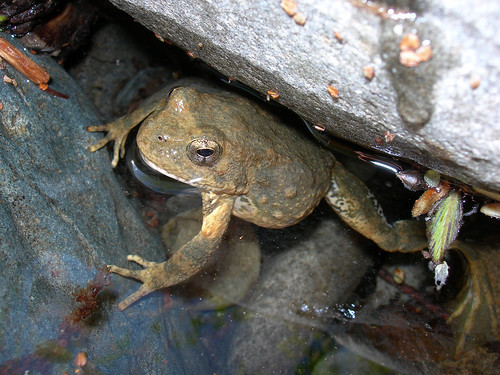
For the foothill yellow-legged frog, breeding can be a challenging matter.
It is the only true frog in western North America that breeds exclusively in streams, preferring warm stream edges. Its eggs can be swept away with spring rains and rapid currents, so a relatively long breeding season allows mates to wait until weather and water conditions offer the best chance for eggs to develop and hatch in this dynamic environment.
But yellow-legged frogs face a new challenge in a Northern California river managed for agriculture, energy, and habitat for steelhead, Chinook salmon and coho salmon.
Researchers from the U.S. Forest Service Pacific Southwest Research Station (PSW) are investigating how cold water releases from dams on the Trinity River affect stream water temperatures and breeding success of the frog, whose populations are declining across California and Oregon.
PSW researchers and collaborators from the U.S. Fish and Wildlife Service monitored frogs in breeding sites along the regulated stretch of river as well as six unregulated tributaries. They documented the timing of breeding and then examined the development of embryos and tadpoles. In the colder, regulated water downstream from the dam, the frogs laid eggs later, the eggs hatched later, and tadpoles were smaller and leaner.
“These results may be attributed to effects of water temperature on frog development and growth, feeding rates, and food quality and quantity,” said Clara Wheeler, a PSW ecologist and lead author of the study.
In dammed rivers like the Trinity and other modified water systems, cold water releases do benefit some species, particularly those fish species that need cooler water for spawning and egg development. But these releases keep the water unnaturally cold in the summer—lowering temperatures by as much as 6.7 degrees Celsius (12.1 degrees Fahrenheit), researchers found—which puts the foothill yellow-legged frog and some other species at a disadvantage.
“Persistently depressed summer water temperatures appear to play a seminal role in inhibited tadpole growth and may be a factor in the decline of this population,” said Wheeler.
Previous research suggests that population declines are also linked to altered flow in these modified water systems.
With California in the midst of a severe, multi-year drought, the wise use of water stored in reservoirs will be critical, and water managers must decide how to balance the water use for agriculture and energy with the protection of fish and wildlife.
“This research informs managers that water temperature influences the fitness of early-stage foothill yellow-legged frogs, and emphasizes the importance of using a multi-species management approach when implementing environmental assessments and executing management decisions,” said Wheeler.
